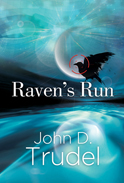
 |
When impeccable research, engaging prose, and a personal connection are fused into one narrative, the result is Raven's Run, a savory, thought-provoking historical thriller with a penchant to discuss events that are at the forefront of western democracy in the 21st century. Audiences will find the plot entertaining and the characters relatable; however, the author's insights into the inner workings of the Kennedy Administration—including the planning for the journey to the moon—are perhaps the most intriguing elements of the novel as they are, to a degree, based on reality. Though the lines between fiction and fact are pleasantly blurred at times during the novel, Trudel provides readers with a "Factoids and Fantasies" section at the end of the book to clear any misconceptions and supply readers with vital source information.
A.C. Wayne, a covert CIA agent narrowly escapes with his life from Natanz, an Iran Fuel Enrichment Plant that doubled as a facility for nuclear weapons. As a reward, he is permanently released by the CIA, which, in turn, leads to an off-the-grid opportunity from Dr. Goldfarb to uncover and foil any nuclear warfare plans against the United States.
An essential, and thoroughly unique element of the story is remote viewing, led by Josie Lynch. In short, remote viewing is essentially a paranormal experience that was initiated at the Rhine Institute in Durham, North Carolina. Ironically, Wayne’s escape was aided by Josie’s incredible remote viewing skills, which ultimately paved a way out of the Natanz facility for Wayne. The romantic relationship between the two is refreshing and enjoyable; two utterly different individuals who discover intimacy through isolation.
The core of the story revolves around the threat of weapons of mass destruction and the propensity for massive riches in oil. From Admiral Richard "Dick" Byrd and naval officer George O. Noville, who led the HIGH JUMP program, to Raven (Wayne's new identity), Josie, and Dr. Goldfarb, numerous characters are tasked with critical responsibilities throughout the story. The character whose name appears in nearly all contexts and references of Natanz is Akbar Safdari, perhaps the strongest antagonistic character in the novel. In a nutshell, "Islamic fundamentalists want a Caliphate and to have the Christian, Jews, and other Muslims who don’t support them dead." Oil revenues switched from being split in 1957 to Iran nationalizing oil in 1974 and claiming full control of oil funds as a result.
Mysterious deaths of high ranking officials, tankers being sunk in the ocean, and treasonous activities reign supreme and hold audiences on edge from the get-go. Throughout, Trudel does an exceptional job of shifting time frames from as early as 1927 all the way to the present day Obama administration. As political thrillers often go, secret missions like STARFISH and SNOWBALL, in addition to the potential for oil in Antarctica, add another dimension to the high-stakes situation.
The inclusion of relevant articles like Harold T. Woolsey's "WHAT'S BLACKWOOD UP TO NOW?" from The Wall Street Journal add credibility to the novel. Being the nephew of George Noville cements the author credibility aspect and only leaves readers desiring for more by the end. Fascinating discussions about the caliphate and corruption in the novel are closely linked to current events and terrorist group, ISIS. Further information regarding Trudel’s writing and his topics can be found on his blog. Ultimately, a seamless blend of dialogue and exposition, coupled with strong flowing prose and a gold mine of historical information, make Raven’s Run a sure-fire must-read while readers wait for the sequel: Raven’s Redemption.
RECOMMENDED by the US Review